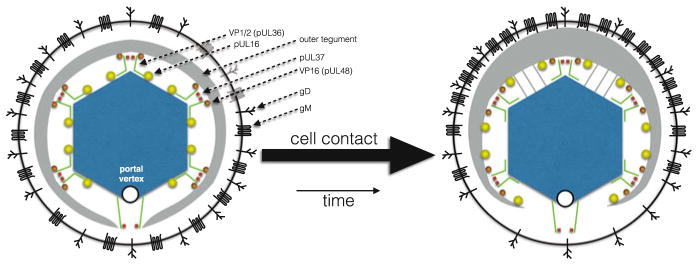Fig. 8.5.
A hypothetical model of the alpha-herpesvirus dynamic architecture. Nascent virions exocytosed from cells have symmetric architectures (left), but typically are asymmetric when harvested from tissue culture media (right). By cryoET, this asymmetry manifests as a thickening of the tegument on one side of the capsid, resulting in the capsid occupying an eccentric position within the confines of the surrounding envelope. Ensemble mapping supports that the pUL16 and VP16 tegument proteins may be absent from a single vertex, which is considered to be the portal vertex in this speculative model. In contrast, the VP1/2 and pUL37 tegument proteins are projected to occupy all 12 vertices. In this model, VP1/2 is depicted to adopt different conformations at the unique portal vertex and pentonal vertices to account for the absence of VP16 at one vertex. Ensemble mapping also indicates that gD is radially distributed in the envelope, while gM is polar. How the gM asymmetry relates to underlying changes in tegument distribution is unknown: in this model, these components have been oriented together. Traditional transmission electron microscopy and cryoET reveal that virion asymmetry is prevalent upon binding to cells, and in separate studies, binding to cells was found to release pUL16 from capsids within virions. Whether the relationship between pUL16 release and tegument asymmetry is causal or coincidental is not known. In addition to cell contact, virions become asymmetric as they age and are noted to acquire additional tegument contacts across the faces of the icosahedral capsid (gray lines). It is unknown if cell-contact-dependent and age-dependent architectural changes in the virion are related, but these events demonstrate the plasticity and dynamic nature of the virion architecture. The illustration is an effort to integrate these independent observations into a simplified model based on a single underlying triggering event that could promote infection, and is intended to promote discussion

